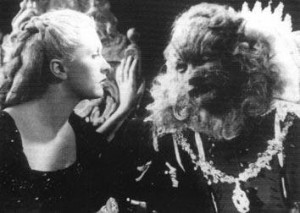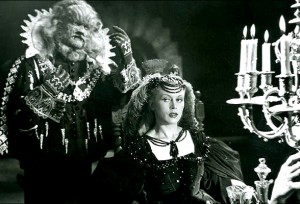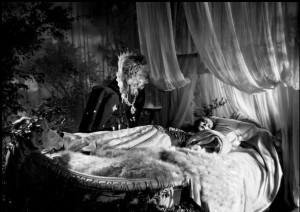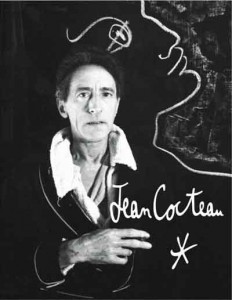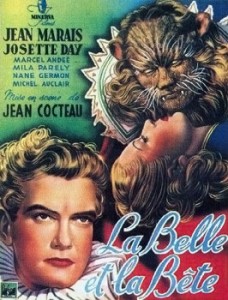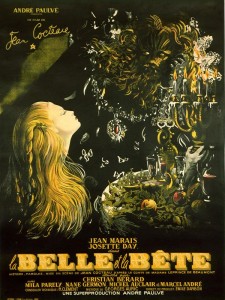La Belle et la Bête [Beauty and the Beast] ***** (1946, Jean Marais, Josette Day, Mila Parély, Marcel André, Nane Germon, Michel Auclair) – Classic Movie Review 345
‘Children believe what we tell them. They have complete faith in us. They believe that a rose plucked from a garden can plunge a family into conflict. They believe that the hands of a human beast will smoke when he slays a victim, and that this will cause the beast shame when a young maiden takes up residence in his home.
‘They believe a thousand other simple things. I ask of you a little of this childlike simplicity, and, to bring us luck, let me speak four truly magic words, childhood’s open sesame: “Once upon a time…”‘ – Jean Cocteau.
Director Jean Cocteau’s 1946 world cinema classic film is a magical masterpiece that casts a unique sensuous spell. Cocteau conjures up a gorgeous and glorious retelling of the famous fairy tale story by Mme Jeanne-Marie Leprince de Beaumont (1711 – 1780). La Belle et la Bête is deservedly renowned for its breath-taking visual beauty, astonishing surreal images and the warmth and imagination behind its expression of cinematic poetic passion.
Marcel André plays Belle’s Father, a hapless merchant who gets lost in a dark forest. He seeks refuge in the castle of a fearful Beast, who threatens to kill him unless one of his three daughters agrees to take his place. Jean Marais stars as the Beast in an extremely haunting and affecting performance.
The Beast, who looks terrifying and predatory, of course soon melts and falls madly in love with the gorgeous Belle [Beauty] (Josette Day) when she goes to his castle to stand in for her father. Marais’s glorious Beast is charged up with repressed lust and melancholy. Day’s Beauty is demure but feisty, overcoming her fears to explore a shadowy realm full of supernatural delights.
Also in the cast are Mila Parély as Félicie, Nane Germon as Adélaïde, Michel Auclair as Ludovic and Raoul Marco as the usurer.
The 1995 print from the restored negative showed this lovely, playful movie wearing extremely well, its story, performances, handling and influential designs still wonderfully imaginative and entirely captivating.
It is more beautiful than ever in a 2013 4K digital restoration by SNC/Groupe M6 and the Cinémathèque Française that uses the notes and reference prints made by cinematographer Henri Alekan for the 1995 restoration, as well as the diary kept by Cocteau during filming, which show his intentions for the look and sound of the film.
Filming in the immediate aftermath of the German occupation of France, Cocteau worked with designer-artist Christian Bérard and two ex-combat cameramen – Alekan and René Clément as technical adviser – to conjure up another world of living statues, talking mirrors and candelabras clutched in disembodied hands. No CGI special effects, just imagination.
The settings for the Beast’s castle were inspired by the dark imagination of 19th-century artist and engraver Gustave Doré, most famous for illustrating a famous nineteenth century French edition of Don Quixote, while the scenes in Beauty’s family home were influenced by Vermeer.
Battling adverse conditions that included a shortage of equipment, location shooting in rain and fog, and studios beset by power cuts, the film-makers’ achievement is miraculous. And with the addition of an eerie orchestral score from Georges Auric, the entire effect is a marvel.
Marais’s Beast make-up took five hours to apply. Marais (1913-98) met Cocteau in 1937 at a stage rehearsal of King Oedipus and they remained close friends until Cocteau’s death in 1963.
Philip Glass composed an opera perfectly synchronised to the film, eliminating the original soundtrack.
Disney’s Beauty and the Beast (1991) retells the tale in animation and the studio remade the story as the live-action musical Beauty and the Beast in 2017.
© Derek Winnert 2013 Classic Movie Review 345
Check out more reviews on http://derekwinnert.com/

![[1]](http://derekwinnert.com/wp-content/uploads/2013/11/11-213x300.jpg)

